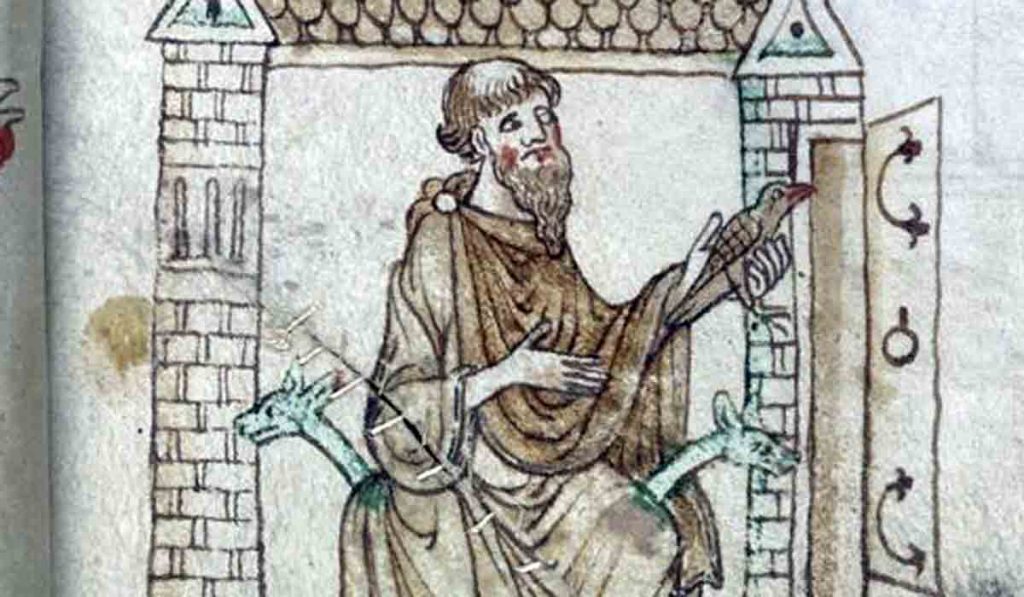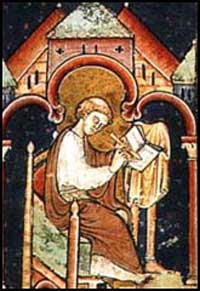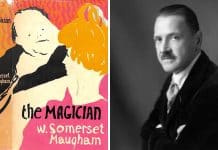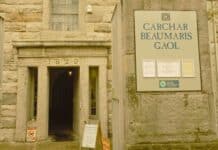JON KANEKO-JAMES pays tribute to the medieval Welsh scholars who wrote the occult

The best of British Mythology comes from the medieval era: not the sanitised works of the 19th century, or the manufactured supernatural of the modern day.
The medieval supernatural has a strange quality of dream-logic, or perhaps it’s tropes just aren’t familiar to us anymore.
Either way, a great deal of what we call the medieval supernatural was recorded as fact by working historians of the time.
Gerald of Wales (Gerald the Welshman)
Gerald was born in 1146, the son of one of the most powerful Anglo-Saxon barons of all time.
He was educated in Gloucester and Paris before eventually becoming the Clerk and Chaplain to King Henry II.
In 1185 he accompanied the King’s son, John, to Ireland, thereby beginning his career with the book Topographia Hibernica.
Topographia was a history of Ireland gathered as he journeyed with John’s Entourage. Three years later he joined Bishop Baldwin of Forde on tour in Wales, recruiting for the Third Crusade.
These books are incredibly important for students of history. While they might not be considered reliable history in their own right (William of Newburgh was one of the most reliable historians of the era, and even his methods are suspect by our own standards)they tell us a great deal about the politics and tradition of their time.
He also had a chance to hear about Werewolves and Poltergeists.

The Werewolf story came from Ossory, now known as County Laois. The story went that a priest was travelling from Ulster towards Meath when night fell more quickly than expected. Travelling only with a young man for company, the priest started a fire and they huddled around it, sheltering from the elements.
Something moved in the undergrowth, and a wolf emerged. Before either of them could react it spoke, “Rest secure, and be not afraid, for there is no reason you should fear where no fear there is!”
The travellers reacted with wonder and alarm, so the wolf added what Gerald calls “…some orthodox words referring to God”.
The priest implored the creature to tell them how it was that a creature in the shape of a beast could utter human words.
After giving Catholic replies to a series of questions the creature said, “There are two of us, a man and a woman, natives of Ossory, who, through the curse of one Natalis, saint and abbot, are compelled every seven years to put off the human form, and depart from the swellings of men. Quitting entirely the human form, we assume that of Wolves. At the end of seven years, if they chance to survive, two others being substituted in their places, they return to their country and return to their former shape. And now, she who is my partner in this cisitation lies dangerously sick.”
The priest followed the wolf, who led him to a hollow where there was a she-wolf, who was pouring forth human sighs and groans. The priest gave her the last rites, and the wolf withdrew, pointing to the hollow of a tree where there was a missal book and some consecrated wafers.
The wolf tore the skin off the she-wolf, folding it back to the waist and showing an old woman underneath. Compelled more by fear than reason, the priest gave the holy communion, the he-wolf rolling the skin back and fitting the old woman into the she-wolf’s form.
The he-wolf then spent the rest of the night with the priest, behaving more like a man than a wolf, and come morning led him out of the forest.
And that wasn’t the only tale of the supernatural that Gerald of Wales recorded. When he completed his book Itinerarium Cambriae (Journey to Wales) he came across a house haunted by what can only be called a Poltergeist:
“In these parts of Pembroke, in our own times, unclean spirits (spiritus immundos) have been in close communication with human beings. They are not visible, but their presence is felt all the same. First, in the house of Stephen Wiriet, then at a later date, in the house of William Not, they have been in the habit of manifesting themselves, throwing refuse all over the place, more keen perhaps to be a nuisance than to do any real harm. In William’s house they were a cause of annoyance to both host and guest alike, ripping up their clothes of linen, and their woolen ones too, and even cutting holes in them. No matter what precautions were taken, there seemed to be no way of protecting these garments, not even if doors were kept bolted and barred. In Stephen’s house things were even more odd, for the spirit there was in the habit of arguing with humans. When they protested, and this they would often do in sport, he would upbraid them in public for every nasty little act they had committed from the day of their birth onward, things that they did not like to heard discussed and which they would have preferred to keep secret…”
Adam of Usk
Adam was born in Monmouthshire, then Usk, in 1352.
He studied Cannon Law at Oxford University, where he received a doctorate in Law and settled as a teacher until he became embroiled in an armed struggle between the North and Southern regions of England.
He was involved in deposing King Richard II, and was awarded a prebendary in the Church of Bangor. He also held a prebend at Llandygwydd in Cardiganshire, but might not have kept it after being accused of highway robbery by a man named Water Jake.
Adam’s Chronicle covered English history from 1377 to 1421, and the kind of history Adam collected shows his deep interest in the strange. One of his entries for 1399 covers perhaps the strangest portent of them all:
“1399, during this parliament, two valets of the king who were dining in London found, in five eggs which were served up to them, the exact likeness of men’s faces in every detail, the whites having congealed, separated from the faces above the forehead in the place of hair before passing down to the jowls of the chin; one of which I saw.”
He also seems to have had an interest in other strange things. Recording a one eyed boy (the eye being in the centre of his forehead) born in Llanbadoc, and an odd two-headed calf: “Which had two necks, two heads, four eyes and four ears…”
Also recording that he saw one aborted in the house of Llugu, in Llancayo, when he was a boy.
Another strange event collected in the Chronicle is a ball of fire that struck in Bruges:
“While I was at Bruges, the aforementioned Earl (of Northumberland) and Lord (Bardolf) were also staying there, the former monastery of Eeckhout, the latter at a hostel in the middle of town. As twilight fell on the eve of St. Brice’s day (12th November), a ball of fire bigger than a large barrel came flying through the air from the direction of England, which seemed to light up the world; everybody who saw it was dumbstruck, terrified that it was going to destroy the town, but it crashed right into the belfry of St. Mary’s, where it split into two pieces which then flew off in different directions and landed at the doors of the adoresaid earl and lord – a terrible portent of disaster for them…”
In fact, Adam’s main supernatural preoccupation seems to have been portents.
He talks about how Richard’s coronation had contained three symbols of royalty that had foretold three misfortunes: he lost a show, which foretold the common people rising against him; one of his spurs dropped off, signifying that the knighthood would rebel against him; thirdly, a sudden gust of wind blew off his crown, showing that he would be deposed.
He also compared the death of Henry IV to his horoscope, saying that his coronation his hair had fallen out, which foreshadowed his death from “festering of the flesh, dehydration of the eyes, and rupture of the internal organs…” saying that dying in the Jerusalem Chamber of Westminster Abbey fulfilled his horoscope prediction that he would die in the hole land.







